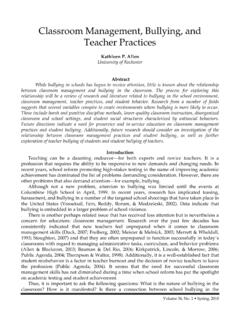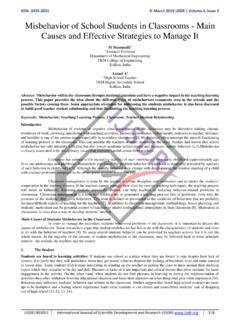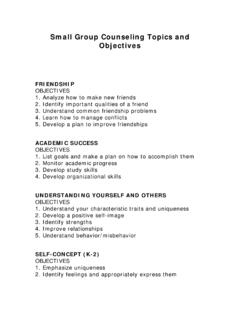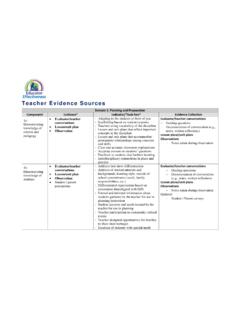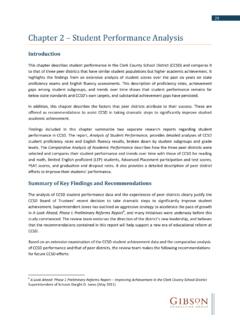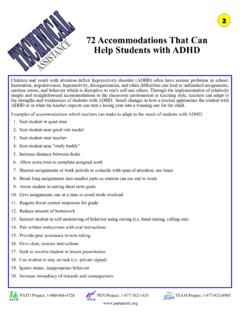Transcription of Managing the Classroom Environment
1 52 CHAPTER 3 Managing the Classroom Environment The greatest sign of success for a teacher .. is to be able to say, The children are now working as if I did not exist. Maria MontessoriBefore We BeginWhat are some responsibilities that today s children have in the Classroom and at home? What additional responsibilities will they have as adults? How can teachers prepare them for these responsibilities? Be ready to compare your view with day we hear about the importance of leaving no child behind, yet, unfortunately, we are leaving American teachers behind! Did you know that up to 50% of American teachers leave their classrooms behind within the first 5 years of entering the profession? One of the major reasons has been the teachers frustration with their lack of preparation to effectively manage their classrooms (Latham & Vogt, 2007).
2 This chapter will focus on Classroom management. students cannot learn and teachers cannot teach in a chaotic Environment . Therefore, teachers must deal effectively with stu-dents misbehavior and promote student self-control so everyone can meet their emotional needs and academic goals. All teachers have management challenges. How they deal with students behavioral choices depends on their educational philosophy and their preferred management approach. To prepare you for that venue, we will examine the principles of three current approaches to Classroom we will explore such issues as beginning the school year on a positive note, estab-lishing Classroom guidelines and rules, monitoring students behavior, identifying causes of misbehavior, and administering appropriate consequences.
3 Finally, you will learn teacher-tested ideas for structuring the Classroom Environment and for conducting daily Classroom 3 Managing the Classroom Environment53 Many beginning teachers harbor concerns about their abilities to manage students behavior. These concerns might be well-founded because teachers, administrators, parents, and students report that misbehavior often interferes with the ability of a teacher to teach and with the ability of students to learn (Charles, 2002; Evertson, Emmer, & Worsham, 2003; Gallup & Elam, 1988). Although such reports suggest that there are serious management and discipline problems in the public schools, it would be a mistake to assume that students are out of control.
4 Let s explore how effective elementary and middle school teachers use Classroom management techniques to encourage students to assume responsibility for their own ROLE OF Classroom MANAGEMENTC lassroom management is the process of organizing and conducting the business of the Classroom . Many perceive it as the preservation of order through teacher control. Classroom management is much more than that, however! It also involves the establishment and maintenance of the Classroom Environment so that educational goals can be accomplished (Savage & Savage, 2010).Effective Classroom managers create orderly, safe environments where students feel valued and comfortable, thus setting the stage for teaching and learning.
5 To achieve that, they strategically arrange Classroom space to support a variety of independent, small and large group activities (Crane, 2001). Elementary teachers also designate a large area of floor space where students can gather for read-alouds, demonstrations, and class meetings. In all classrooms, there should be no blind areas in the room where students can be out of view. To structure traffic flow and minimize disruption, teachers separate high-traffic areas such as group work areas, learning centers, students desks, the teacher s desk, After completing your study of Chapter 3, you should be able to define Classroom management, and identify its various aspects; describe the self-discipline approach, instructional approach, and desist approach to Classroom management; specify causes of Classroom misbehavior; describe organizational techniques that lead to effective Classroom management; summarize teacher-tested techniques for proactively preventing Classroom management problems.
6 And discuss the use of appropriate rt I Se t tI n g t h e Stag e f o r Su c c eS Sf u l le a r nI n g54the pencil sharpener, bookshelves, computer stations, and storage areas. Teachers ensure plentiful room for student movement, especially for students who have physical handicaps. Furthermore, they decide how to store Classroom materials, including students personal items, textbooks, resource books, instructional materials, frequently used materials, and equipment. Finally, they decide what materials will be accessible by students and which areas are designated for teacher use not its sole component, discipline is another highly important aspect of class-room management. Discipline is a systematic way of teaching students to assume respon-sibility for their behavioral choices; punishment focuses upon negative consequences for misbehavior.
7 This chapter will focus on discipline rather than punishment even though your success as a Classroom teacher will depend on your adequacy in making sound deci-sions in both of these elementary and middle school teachers create optimal learning environments by establishing and enforcing rules, creating caring teacher student relationships, address-ing problem behaviors, and using quality communication. students of all ages may have behavioral, attitudinal, and social issues. Older students problems, however, are more long standing and thus more difficult to address. Many middle school students resist authority and place greater importance on peer norms. Furthermore, because most middle school students have more advanced reasoning skills than younger students , they generally demand more elaborate and logical explanation of rules and discipline.
8 Keep these differ-ences between elementary and middle school students in mind as we explore effective Classroom management are a number of Classroom management strategies available to teachers. Let s begin by taking a look at three management approaches. These three approaches to class-room management form a continuum, from the self-discipline approach at one extreme, to the instructional approach, to the desist approach at the opposite Self-Discipline ApproachThe self-discipline approach is built on the premise that students can be trusted to reflect upon and regulate their behaviors to benefit themselves and others. Advocates for this democratic view of Classroom management argue that teachers need to exhibit the dispo-sitions of respect, realness, trust, acceptance, and empathy toward students so they can build and establish working teacher-student relationships.
9 Different variations of this man-agement approach include William Glasser s (1965, 1977, 1986) reality therapy, Thomas Gordon s (1974) teacher effectiveness training (TET), Barbara Coloroso s (2002) inner discipline, and Alfie Kohn s (1996) beyond Instructional ApproachTeachers who use the instructional approach to Classroom management prevent most management problems by actively engaging students in high-interest lessons geared to meet their interests, needs, and abilities. Thus, students are motivated to attend class, positively participate in activities, and manage their own behavior. Jacob Kounin (1970) and Frederick Jones (1979) advocate the instructional approach to class-room 3 Managing the Classroom Environment55 The Desist ApproachThe desist approach to Classroom management gives the teacher full responsibility for regulating the Classroom .
10 The teacher establishes and enforces a set of specific rules to control student behavior in the Classroom . Because the desist approach models of class-room management give teachers power to deal forcefully and quickly with misbehavior, they can be viewed as power systems. This approach probably is the most widely used Classroom management strategy in today s schools. The desist approach is advocated by Lee and Marlene Canter (1976) in their assertive discipline model and by B. F. Skinner (1968, 1971) in his research on behavior on teacheR PRactice : Getting students MotivatedSOURCE: Reprinted with What evidence suggests that many adolescents are self-centered?










